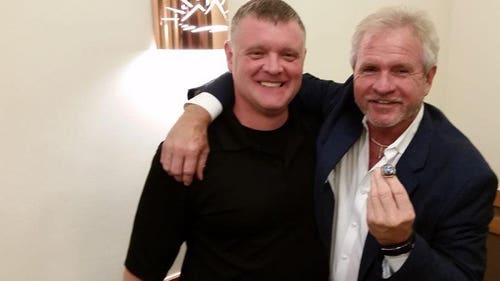Foltynewicz velo strong in All-Star's fresh start with Texas
Mike Foltynewicz is almost as perplexed about how quickly his velocity has returned this spring with the Texas Rangers as the former All-Star was about how quickly it went away last summer when his former team gave up on him.
The right-hander peeked at the scoreboard after the first pitch of his spring training debut Sunday with Texas and saw 95 mph. He also hit 96-97 mph on other pitches.
“Last year, I just literally don’t know what happened,” Foltynewicz said. “I kept throwing and I kept doing everything I needed to do. And I just don’t know what happened. So for all of this to play out right now ... just to see those numbers, yes, it’s very assuring, and that tick of confidence goes up a little bit more.”
For both Foltynewicz and the pitching-needy Rangers, who unlike the playoff-bound Atlanta Braves in the shortened season last summer, have some time to find out if the 29-year-old right-hander is getting back to form.
Those two perfect innings against the defending World Series champion Los Angeles Dodgers in Arizona were an encouraging first step.
“That exceeded my expectations,” manager Chris Woodward said. “It meant the world to him to kind of get back out there and, you know, resemble his old self. And it was easy. It wasn’t like he was trying to force it to be 95, 96 (mph). It just was natural. It’s just the way his body was moving, which it had in the past.”
Foltynewicz has added back at least 10 pounds to his lanky 6-foot-4 frame, regaining some strength lost during baseball's shutdown because of the pandemic that started in spring training and lasted about four months.
In his only start once the season began, he allowed six runs, three homers and four walks in 3 1/3 innings with a flat fastball at around 90 mph. The Braves designated him for assignment after that 14-5 loss to Tampa Bay, sent him to their alternate site when he wasn't claimed off waivers and didn't offer a new contract after the season.
While a bit surprised by the move last summer, Foltynewicz said he understood the Braves were trying to win a championship in a short season — they did get to the NL Championship Series played at the Rangers' new ballpark, and he was there without playing.
“They gave me plenty of chances in the past,” he said. “It's a business, I get all of that part of it. But in the back of the mind, it kind of fuels you a little bit when someone gives up on you like that.”
An All-Star in 2018, when he was 13-10 with a 2.85 ERA in 31 regular-season starts, Foltynewicz was sent back to Triple-A midway through the 2019 season to work out some early-season issues. He finished strong after getting called back up, then pitched seven scoreless innings against St. Louis in Game 2 of the NL Division Series. But he also started the deciding Game 5 when the Cardinals had a 10-run first inning.
Foltynewicz signed a $2 million, one-year contract with Texas just before the start of spring training and is not eligible for free agency until after the 2022 season.
Even though Foltynewicz was throwing and running every day when players were away from their teams last year, with gyms closed and lacking certain equipment, he wasn't able to maintain his strength by doing squats and other weights workouts. The impact was obvious, though Foltynewicz and the Rangers said explaining his regained velocity now isn't just as simple as regained strength.
“There’s so much more than that,” Woodward said.
While Foltynewicz made adjustments to his eating habits and lifestyle, there was also the biomechanical and analytical approach Rangers pitching coaches presented to him even before he signed with them.
“Basically diagnosing some of the problems or the things that they could help fix, I think that’s what really set maybe us apart from other teams in his mind,” Woodward said. “And you see the impact that it’s had already. His first outing was it was beyond what I even expected. I was expecting it to be decent, but that was pretty dominant.”
It was the kind of velocity that made Foltynewicz successful in the past, since all of his other pitches — slider, changeup and curveball — then work off that.
After that initial 95 mph pitch which got out Mookie Betts on a flyball, Foltynewicz said he was able to take a deep breath and then attack hitters and use all of his stuff.
“You get weak contact, strikeouts, whatever it may be, and you just have fun," he said. ”You start having fun again in the game of baseball."
___
More AP MLB: https://apnews.com/hub/MLB and https://twitter.com/AP_Sports









